Abstract
Purpose
The aim of this study was to evaluate the effect of mechanical, chemical surface treatments on the zirconia-to-resin cement shear bond strength (SBS).
Materials and methods
Eighty zirconia discs (Lava, 3M ESPE) and eighty zirconia/alumina composite (Zirace, Acucera) were embedded in an epoxy resin base. Zirconia discs were randomly divided in to four treatment groups(10 for each manufacturer): 50 μ m Al2O3 sandblasting (S50),110 μ m Al2O3 sandblasting (S110), 50 μ m Al2O3 and primer (Z-Prime Plus, Bisco Inc) (S50z) and 110 μ m Al2O3 and primer (Z-Prime Plus) (S110z). Two resin-based luting cements (Calibra, Panavia F) were used to build 2 mm-diameter cylinders onto the zirconia. After 24 h of storage in water, SBS testing was evaluate using a universal testing machine. Bond strength data were analyzed with one-way ANOVA, two-way ANOVA test and post hoc comparison was done using Tukey test (α = .05).
Go to : 
REFERENCES
1.Blatz MB., Sadan A., Kern M. Resin-ceramic bonding: a review of the literature. J Prosthet Dent. 2003. 89:268–74.

2.Blatz MB., Chiche G., Holst S., Sadan A. Influence of surface treatment and simulated aging on bond strengths of luting agents to zirconia. Quintessence Int. 2007. 38:745–53.
3.Luthardt RG., Holzhu ¨ter M., Sandkuhl O., Herold V., Schnapp JD., Kuhlisch E., Walter M. Reliability and properties of ground Y-TZP-zirconia ceramics. J Dent Res. 2002. 81:487–91.
4.Luthardt R., Weber A., Rudolph H., Scho ¨ne C., Quaas S., Walter M. Design and production of dental prosthetic restorations: basic research on dental CAD/CAM technology. Int J Comput Dent. 2002. 5:165–76.
5.Kakehashi Y., Lu ¨thy H., Naef R., Wohlwend A., Scha ¨rer P. A new all-ceramic post and core system: clinical, technical, and in vitro results. Int J Periodontics Restorative Dent. 1998. 18:586–93.
6.Meyenberg KH., Lu ¨thy H., Scha ¨rer P. Zirconia posts: a new all-ceramic concept for nonvital abutment teeth. J Esthet Dent. 1995. 7:73–80.

7.Yildirim M., Fischer H., Marx R., Edelhoff D. In vivo fracture resistance of implant-supported all-ceramic restorations. J Prosthet Dent. 2003. 90:325–31.

8.Glauser R., Sailer I., Wohlwend A., Studer S., Schibli M., Scha ¨rer P. Experimental zirconia abutments for implant-supported single-tooth restorations in esthetically demanding regions: 4-year results of a prospective clinical study. Int J Prosthodont. 2004. 17:285–90.
9.De′rand P., De′rand T. Bond strength of luting cements to zirconium oxide ceramics. Int J Prosthodont. 2000. 13:131–5.
10.O ¨zcan M., Vallittu PK. Effect of surface conditioning methods on the bond strength of luting cement to ceramics. Dent Mater. 2003. 19:725–31.
11.Zhang Y., Lawn BR., Malament KA., Van Thompson P., Rekow ED. Damage accumulation and fatigue life of particle-abraded ceramics. Int J Prosthodont. 2006. 19:442–8.
12.Zhang Y., Lawn BR., Rekow ED., Thompson VP. Effect of sandblasting on the long-term performance of dental ceramics. J Biomed Mater Res B Appl Biomater. 2004. 71:381–6.

13.Wolfart M., Lehmann F., Wolfart S., Kern M. Durability of the resin bond strength to zirconia ceramic after using different surface conditioning methods. Dent Mater. 2007. 23:45–50.

14.Kern M., Wegner SM. Bonding to zirconia ceramic: adhesion methods and their durability. Dent Mater. 1998. 14:64–71.

15.Blatz MB., Sadan A., Martin J., Lang B. In vitro evaluation of shear bond strengths of resin to densely-sintered high-purity zirconium-oxide ceramic after long-term storage and thermal cycling. J Prosthet Dent. 2004. 91:356–62.

16.Atsu SS., Kilicarslan MA., Kucukesmen HC., Aka PS. Effect of zirconium-oxide ceramic surface treatments on the bond strength to adhesive resin. J Prosthet Dent. 2006. 95:430–6.

17.Tanaka R., Fujishima A., Shibata Y., Manabe A., Miyazaki T. Cooperation of phosphate monomer and silica modification on zirconia. J Dent Res. 2008. 87:666–70.

18.Tsuo Y., Yoshida K., Atsuta M. Effects of alumina-blasting and adhesive primers on bonding between resin luting agent and zirconia ceramics. Dent Mater J. 2006. 25:669–74.

19.Aida M., Hayakawa T., Mizukawa K. Adhesion of composite to porcelain with various surface conditions. J Prosthet Dent. 1995. 73:464–70.

20.Lu ¨thy H., Loeffel O., Hammerle CH. Effect of thermocycling on bond strength of luting cements to zirconia ceramic. Dent Mater. 2006. 22:195–200.
21.Akgungor G., Sen D., Aydin M. Influence of different surface treatments on the short-term bond strength and durability between a zirconia post and a composite resin core material. J Prosthet Dent. 2008. 99:388–99.

22.Wegner SM., Kern M. Long-term resin bond strength to zirconia ceramic. J Adhes Dent. 2000. 2:139–47.
23.Matinlinna JP., Heikkinen T., Ozcan M., Lassila LV., Vallittu PK. Evaluation of resin adhesion to zirconia ceramic using some organosilanes. Dent Mater. 2006. 22:824–31.

24.Kern M., Thompson VP. Sandblasting and silica coating of a glass-infiltrated alumina ceramic: volume loss, morphology, and changes in the surface composition. J Prosthet Dent. 1994. 71:453–61.

25.Della Bona A., Borba M., Benetti P., Cecchetti D. Effect of surface treatments on the bond strength of a zirconia-reinforced ceramic to composite resin. Braz Oral Res. 2007. 21:10–5.
26.Uo M., Sjo ¨gren G., Sundh A., Goto M., Watari F., Bergman M. Effect of surface condition of dental zirconia ceramic (Denzir) on bonding. Dent Mater J. 2006. 25:626–31.

27.Kosmac T., Oblak C., Jevnikar P., Funduk N., Marion L. Strength and reliability of surface treated Y-TZP dental ceramics. J Biomed Mater Res. 2000. 53:304–13.
28.Guazzato M., Quach L., Albakry M., Swain MV. Influence of surface and heat treatments on the flexural strength of Y-TZP dental ceramic. J Dent. 2005. 33:9–18.

29.Wang H., Aboushelib MN., Feilzer AJ. Strength influencing variables on CAD/CAM zirconia frameworks. Dent Mater. 2008. 24:633–8.

30.Karakoca S., Yilmaz H. Influence of surface treatments on surface roughness, phase transformation, and biaxial flexural strength of Y-TZP ceramics. J Biomed Mater Res B Appl Biomater. 2009. 91:930–7.

31.Kern M., Thompson VP. Bonding to glass infiltrated alumina ceramic: adhesive methods and their durability. J Prosthet Dent. 1995. 73:240–9.

32.Tanaka T., Nagata K., Takeyama M., Atsuta M., Nakabayashi N., Masuhara E. 4-META opaque resin-a new resin strongly adhesive to nickel-chromium alloy. J Dent Res. 1981. 60:1697–706.
33.Lindgren J., Smeds J., Sjo ¨gren G. Effect of surface treatments and aging in water on bond strength to zirconia. Oper Dent. 2008. 33:675–81.

34.Silikas N., Wincott PL., Vaughan D., Watts DC., Eliades G. Surface characterization of precious alloys treated with thione metal primers. Dent Mater. 2007. 23:665–73.

35.O ¨zcan M., Nijhuis H., Valandro LF. Effect of various surface conditioning methods on the adhesion of dual-cure resin cement with MDP functional monomer to zirconia after thermal aging. Dent Mater J. 2008. 27:99–104.
Go to : 
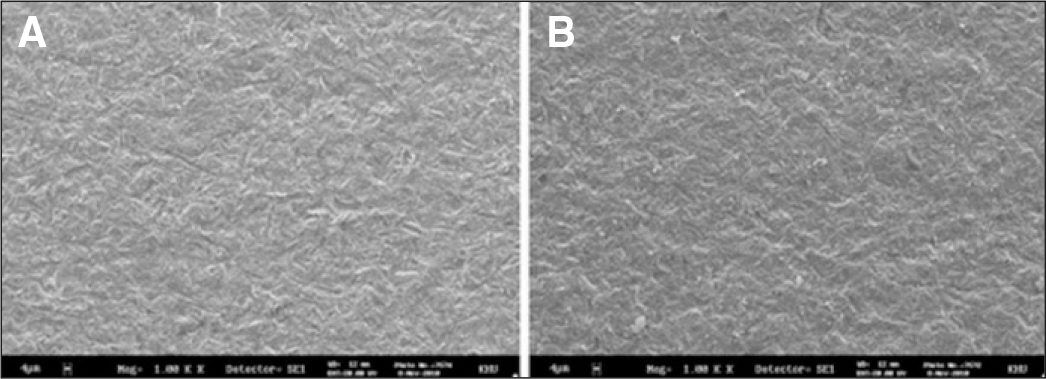 | Fig. 5.SEM image of Lava after sandblasting (magnification ×1,000). The roughness of the surface is suitable for the mechanical interlocking between zirconia and resin cement. A: 50 μ m Al2O3 sandblasting, B: 110 μ m Al2O3 sandblasting. |
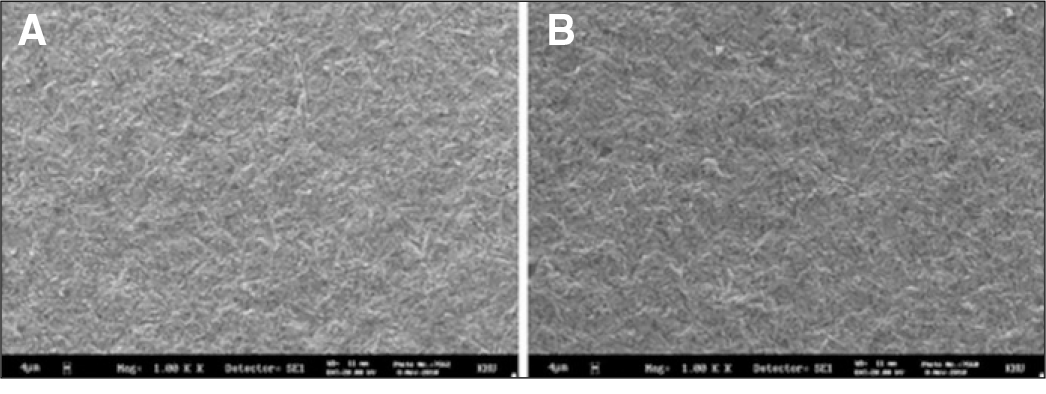 | Fig. 6.SEM image of Zirace after sandblasting (magnification ×1000). The pattern morphology is similar between 50 μ m Al2O3 sandblasting (A) and 110 μ m Al2O3 sandblasting (B). A: 50 μ m Al2O3 sandblasting, B: 110 μ m Al2O3 sandblasting. |
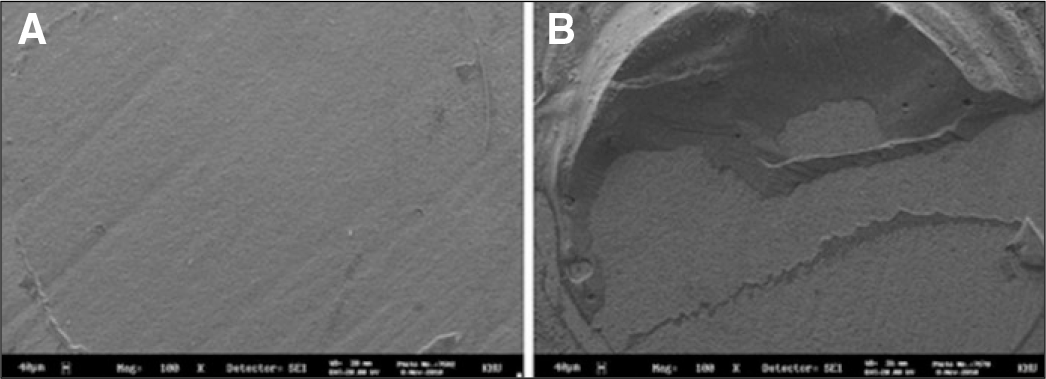 | Fig. 7.SEM image of failure mode (magnification ×100). A: Adhesive failure mode, B: Mixed failure mode. |
Table 1.
Experimental materials
Table 2.
Ex perimental gro ups
Table 3.
Shear bond strength means in MPa (SD) by resin cement and surface treatment
Table 4.
Failure mode after SBS testing




 PDF
PDF ePub
ePub Citation
Citation Print
Print



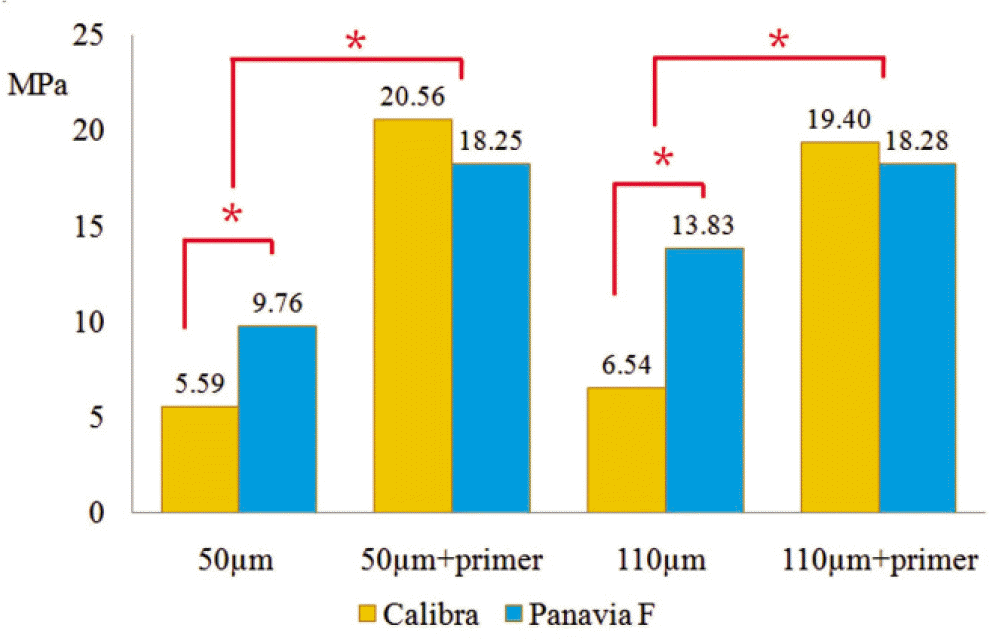
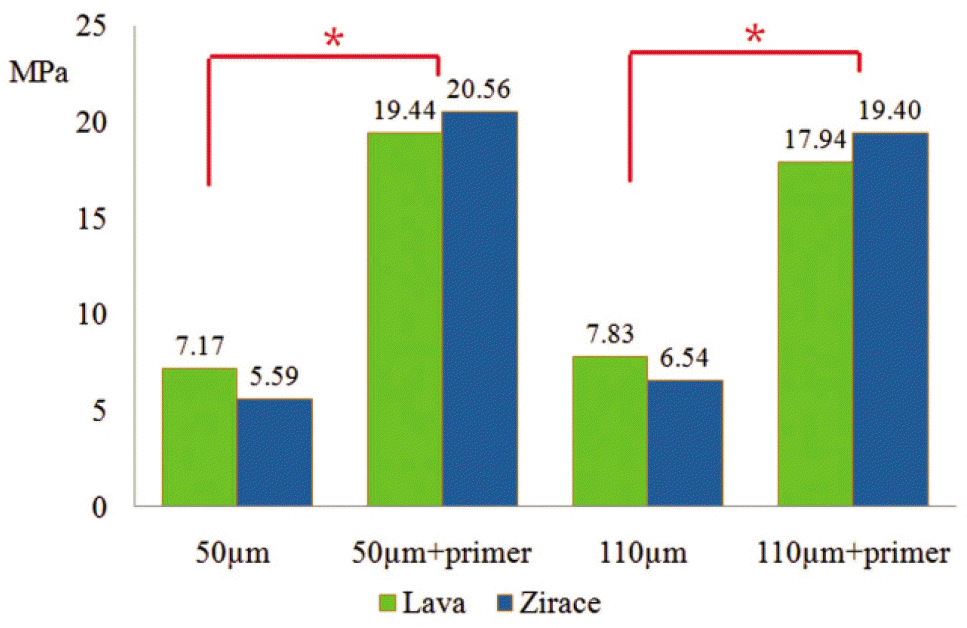

 XML Download
XML Download